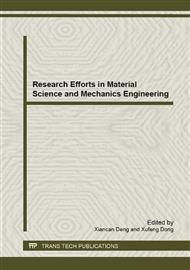[1]
M.E. Martellotti, An Analysis of the Milling Process, Journal of Engineering for Industry. 63 (1941) 677-700.
Google Scholar
[2]
J. Tlusty, P. MacNeil, Dynamics of cutting forces in end milling, CIRP. 24 (1975) 21-25.
Google Scholar
[3]
J.W. Sutherland, A Dynamic Model of the Cutting Force System in End Milling Process, Proceeding, ASME Symposium on Sensors and Controls for Manufacturing. 33 (1988) 53-62.
Google Scholar
[4]
W.A. Kline, R.E. Devor, J.R. Lindberg, The Prediction of Cutting Forces in End Milling with Application to Cornering Cuts, International Journal of Machine Tool Design and Research. 22 (1982) 7-22.
DOI: 10.1016/0020-7357(82)90016-6
Google Scholar
[5]
W.A. Kline, R.E. DeVor, The Effect of Runout on Cutting Geometry and Forces in End Milling, International Journal of Machine Tool Design and Research. 23 (1983) 123-140.
DOI: 10.1016/0020-7357(83)90012-4
Google Scholar
[6]
J.W. Sutherland, R.E. DeVor, An Improved Method for Cutting Force and Surface Error Prediction in Flexible End Milling Systems, Transactions of the ASME Journal of Engineering for Industry. 108 (1986) 269-279.
DOI: 10.1115/1.3187077
Google Scholar
[7]
E.J.A. Armarego, N.P. Deapande, Computerized Predictive Cutting Model for Cutting Forces in End-milling Including Eccentricity Effects, Annals of the CIRP. 38 (1989) 45-49.
DOI: 10.1016/s0007-8506(07)62649-3
Google Scholar
[8]
W.S. Yun, D.W. Cho, An Improved Method for the Determination of 3D Cutting Force Coefficients and Runout Parameters in End Milling, International Journal of Advanced Manufacturing Technology. 16 (2000) 851-858.
DOI: 10.1007/s001700070001
Google Scholar
[9]
W.S. Yun, D.W. Cho, Accurate 3D Cutting Force Prediction Using Cutting-condition-independent Coefficients in End Milling, International Journal of Advanced Manufacturing Technology. 41 (2001) 463-478.
DOI: 10.1016/s0890-6955(00)00097-3
Google Scholar
[10]
M. Wan, W.H. Zhang, G.H. Qin, G. Tan, Efficient Calibration of Instantaneous Cutting Force Coefficients and Runout Parameters for General End Mills, International Journal of Machine Tool & Manufacture. 47 (2007) 1767-1776.
DOI: 10.1016/j.ijmachtools.2006.06.012
Google Scholar
[11]
M Wan, W.H. Zhang, G.H. Qin, Z.P. Wang, Consistency Study on Three Cutting Force Modelling Methods for Peripheral Milling, Engineering Manufacture. 222 (2008) 665-676.
DOI: 10.1243/09544054jem1085
Google Scholar


